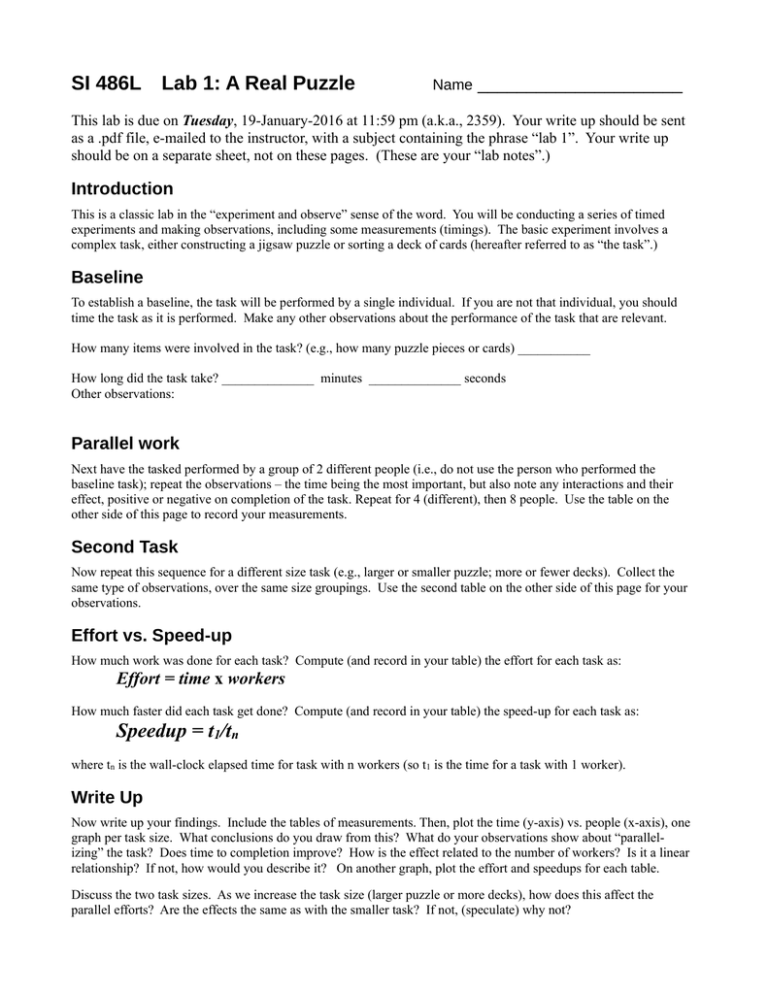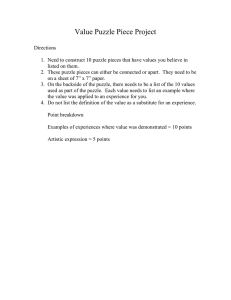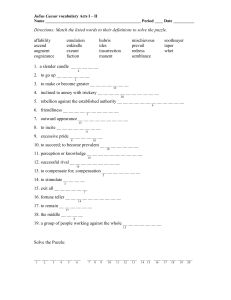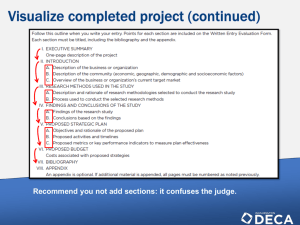SI 486L Lab 1: A Real Puzzle _____________________
advertisement

SI 486L Lab 1: A Real Puzzle Name _____________________ This lab is due on Tuesday, 19-January-2016 at 11:59 pm (a.k.a., 2359). Your write up should be sent as a .pdf file, e-mailed to the instructor, with a subject containing the phrase “lab 1”. Your write up should be on a separate sheet, not on these pages. (These are your “lab notes”.) Introduction This is a classic lab in the “experiment and observe” sense of the word. You will be conducting a series of timed experiments and making observations, including some measurements (timings). The basic experiment involves a complex task, either constructing a jigsaw puzzle or sorting a deck of cards (hereafter referred to as “the task”.) Baseline To establish a baseline, the task will be performed by a single individual. If you are not that individual, you should time the task as it is performed. Make any other observations about the performance of the task that are relevant. How many items were involved in the task? (e.g., how many puzzle pieces or cards) ___________ How long did the task take? ______________ minutes ______________ seconds Other observations: Parallel work Next have the tasked performed by a group of 2 different people (i.e., do not use the person who performed the baseline task); repeat the observations – the time being the most important, but also note any interactions and their effect, positive or negative on completion of the task. Repeat for 4 (different), then 8 people. Use the table on the other side of this page to record your measurements. Second Task Now repeat this sequence for a different size task (e.g., larger or smaller puzzle; more or fewer decks). Collect the same type of observations, over the same size groupings. Use the second table on the other side of this page for your observations. Effort vs. Speed-up How much work was done for each task? Compute (and record in your table) the effort for each task as: Effort = time x workers How much faster did each task get done? Compute (and record in your table) the speed-up for each task as: Speedup = t1/tn where tn is the wall-clock elapsed time for task with n workers (so t1 is the time for a task with 1 worker). Write Up Now write up your findings. Include the tables of measurements. Then, plot the time (y-axis) vs. people (x-axis), one graph per task size. What conclusions do you draw from this? What do your observations show about “parallelizing” the task? Does time to completion improve? How is the effect related to the number of workers? Is it a linear relationship? If not, how would you describe it? On another graph, plot the effort and speedups for each table. Discuss the two task sizes. As we increase the task size (larger puzzle or more decks), how does this affect the parallel efforts? Are the effects the same as with the smaller task? If not, (speculate) why not? First Task Group size Task size (people) (# of items) Time to Effort Complete units: (units:_______) Speedup Observations 1 2 4 8 Second Task Now repeat this sequence for a different size task (e.g., larger or smaller puzzle; more or fewer decks). Collect the same type of observations, over the same size groupings. Group size Task size (people) (# of items) 1 2 4 8 Time to Effort Complete units: (units:_______) Speedup Observations




